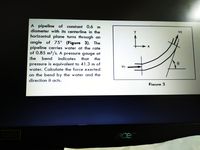
Elements Of Electromagnetics
7th Edition
ISBN: 9780190698614
Author: Sadiku, Matthew N. O.
Publisher: Oxford University Press
expand_more
expand_more
format_list_bulleted
Topic Video
Question

Transcribed Image Text:A pipeline of constant 0.6
diameter with its centerline in the
horizontal plane turns through an
m
U2
of 75° (Figure
angle
pipeline carries water at the rate
of 0.85 m3/s. A pressure gauge at
3). The
she
bend
indicates
that
the
pressure is equivalent to 41.3 m of
water. Calculate the force exerted
U1
on the bend by the water and the
direction it acts.
Fiaure 3
1080
ace
Expert Solution
This question has been solved!
Explore an expertly crafted, step-by-step solution for a thorough understanding of key concepts.
This is a popular solution
Trending nowThis is a popular solution!
Step by stepSolved in 5 steps

Knowledge Booster
Learn more about
Need a deep-dive on the concept behind this application? Look no further. Learn more about this topic, mechanical-engineering and related others by exploring similar questions and additional content below.Similar questions
- Plz solve correctlyarrow_forwardDerive the dynamic equation in terms of the height h for the following fluid system. Assume laminar flow in the orifice. Assume p to be density of the fluid and g gravity. a is the area of the pipe. A H -Pi+Pa R L Paarrow_forwardIn Figure below, a syringe has a piston moves to the right at speed of 18 mm/s by mean of force 2.25 N with no leakage. Find the lengths of each of the cylinder and the needle, if the diameters of the cylinder=5mm and the needle=D0.3 mm respectively? [Take the viscosity is 9.8*10^ -4 Pa.s and the density of medication is 800 kg/m^ 3]. Cylinder Muscle F-2.25 N Needle v=18 mm/s 110 mmarrow_forward
- Please fastarrow_forwardHelp !! Don't copy from othersites ,write the variables clearly. Solve using the energy equation.arrow_forwardWhen a pitot tube as shown below is placed in a river with its lower open end facing upstream, water rises in the vertical portion to a height of 50mm above the water surface. Find the flow velocity U. [density of water ρ = 1000kg/m3]arrow_forward
- Problem 3: Water issues from a hole in a large tank, as shown in the attached figure.Assuming frictionless flow, find L.arrow_forwardHelp with this practice questionarrow_forwardQ: Consider fully developed laminar flow in the annular space formed by the two concentric cylinders shown in the below diagram. The outer pipe is stationary, and the inner pipe moves in the x direction with speed V For pressure gradient, , and the inner cylinder stationary, let ro = R and r = kR, The velocity profile is ax given by: др + 4μ. θα Find: 1- Volume flow rate (Q). 2- An expression for the average velocity (V) 3- Fork → 0, find Q and V 6arrow_forward
- Water flows steadily through a horizontal 30 degree pipe bend. At the inlet point 1, the diameter is 0.3 m, the velocity is 12 m/s, and the pressure is 128 kPa gauge. At the outlet point 2, the diameter is 0.38 m and the pressure is 145 kPa gauge. Determine the forces F_x and F_y necessary to hold the pipe stationary.arrow_forwardYour team is designing a chemical processing plant. You are the liquid handling and transportation specialist, and you need to transport a solvent (μ = 3.1 cP, ρ = 122k kg/m3) from a storage tank to a reaction vessel. Due to other equipment constraints, the fluid velocity must be 0.8 m/sec, and you must use stainless steel piping (ε = 0.00015 mm) with a total length (L) of 12 m. Determine the pipe inner diameter (ID) you will need to achieve a pressure drop of 0.3 kPa. Use the Moody chart.arrow_forwardQuestion 1: Water is expelled by a jet to the environment (i.e. the water flow is surrounded by atmospheric pressure). To change the direction of the water flow, this enters to a curved pipe as show in the figure (top view perspective). Calculate the forces exerted by the flow to the pipe in x and y direction (both horizontal). Use a water density of 1000 kg/m³, Q=1 m³/s, diameter d-0.3 m. Follow the 4 steps explained in the lectures and state your assumptions clearly. 30 Question 2: Repeat question 1 but change the curvature from 30 degrees to 90 degrees. How the forces change? 90arrow_forward
arrow_back_ios
SEE MORE QUESTIONS
arrow_forward_ios
Recommended textbooks for you
 Elements Of ElectromagneticsMechanical EngineeringISBN:9780190698614Author:Sadiku, Matthew N. O.Publisher:Oxford University Press
Elements Of ElectromagneticsMechanical EngineeringISBN:9780190698614Author:Sadiku, Matthew N. O.Publisher:Oxford University Press Mechanics of Materials (10th Edition)Mechanical EngineeringISBN:9780134319650Author:Russell C. HibbelerPublisher:PEARSON
Mechanics of Materials (10th Edition)Mechanical EngineeringISBN:9780134319650Author:Russell C. HibbelerPublisher:PEARSON Thermodynamics: An Engineering ApproachMechanical EngineeringISBN:9781259822674Author:Yunus A. Cengel Dr., Michael A. BolesPublisher:McGraw-Hill Education
Thermodynamics: An Engineering ApproachMechanical EngineeringISBN:9781259822674Author:Yunus A. Cengel Dr., Michael A. BolesPublisher:McGraw-Hill Education Control Systems EngineeringMechanical EngineeringISBN:9781118170519Author:Norman S. NisePublisher:WILEY
Control Systems EngineeringMechanical EngineeringISBN:9781118170519Author:Norman S. NisePublisher:WILEY Mechanics of Materials (MindTap Course List)Mechanical EngineeringISBN:9781337093347Author:Barry J. Goodno, James M. GerePublisher:Cengage Learning
Mechanics of Materials (MindTap Course List)Mechanical EngineeringISBN:9781337093347Author:Barry J. Goodno, James M. GerePublisher:Cengage Learning Engineering Mechanics: StaticsMechanical EngineeringISBN:9781118807330Author:James L. Meriam, L. G. Kraige, J. N. BoltonPublisher:WILEY
Engineering Mechanics: StaticsMechanical EngineeringISBN:9781118807330Author:James L. Meriam, L. G. Kraige, J. N. BoltonPublisher:WILEY

Elements Of Electromagnetics
Mechanical Engineering
ISBN:9780190698614
Author:Sadiku, Matthew N. O.
Publisher:Oxford University Press

Mechanics of Materials (10th Edition)
Mechanical Engineering
ISBN:9780134319650
Author:Russell C. Hibbeler
Publisher:PEARSON

Thermodynamics: An Engineering Approach
Mechanical Engineering
ISBN:9781259822674
Author:Yunus A. Cengel Dr., Michael A. Boles
Publisher:McGraw-Hill Education

Control Systems Engineering
Mechanical Engineering
ISBN:9781118170519
Author:Norman S. Nise
Publisher:WILEY

Mechanics of Materials (MindTap Course List)
Mechanical Engineering
ISBN:9781337093347
Author:Barry J. Goodno, James M. Gere
Publisher:Cengage Learning

Engineering Mechanics: Statics
Mechanical Engineering
ISBN:9781118807330
Author:James L. Meriam, L. G. Kraige, J. N. Bolton
Publisher:WILEY